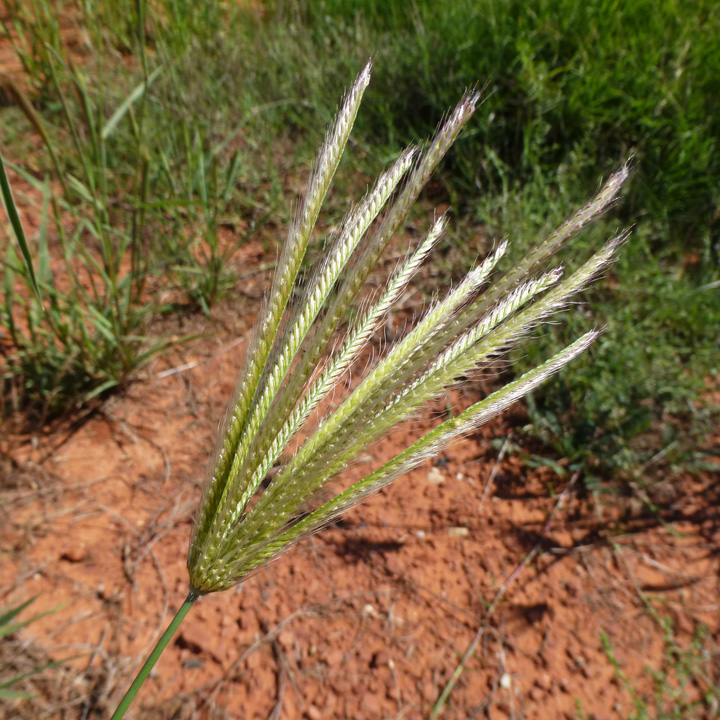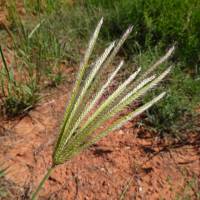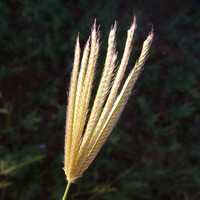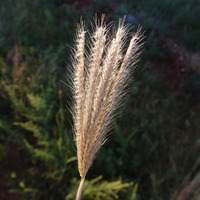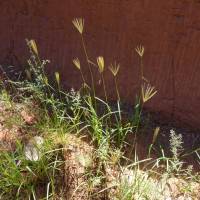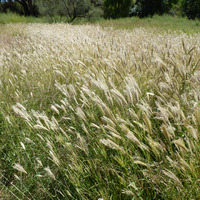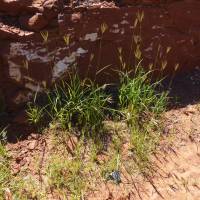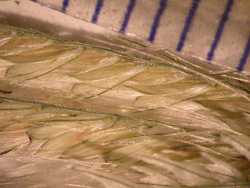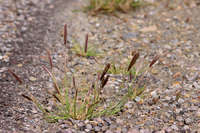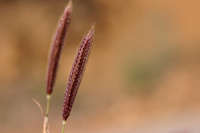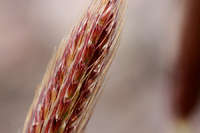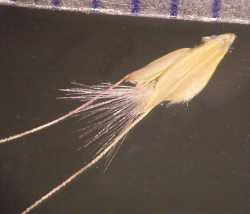Plants annual; usually tufted, occasionally stoloniferous. Culms 10-100+ cm. Sheaths usually glabrous; ligules to 4 mm, erose or ciliate; blades to 30 cm long, to 15 mm wide, basal hairs to 4 mm, otherwise usually glabrous, occasionally pilose. Panicles digitate, with 4-20, evidently distinct branches; branches 5-10 cm, erect to ascending, averaging 10 spikelets per cm. Spikelets strongly imbricate, with 1 bisexual and 1(2) sterile floret(s). Lower glumes 1.5-2.5 mm; upper glumes 2.5-4.3 mm; lowest lemmas 2.5-4.2 mm, keels usually prominently gibbous, glabrous, or conspicuously pilose, sides not grooved, margins glabrous, scabrous or pilose basally, with conspicuously longer hairs distally, hairs longer than 1.5 mm, lemma apices not conspicuously bilobed, awned, awns 2.5-15 mm; second florets 1.4-2.9 mm long, 0.4-0.8 mm wide, somewhat widened distally, not inflated, bilobed, lobes less than 1/5 as long as the lemmas, awned from the sinuses, awns 3-9.5 mm; third florets greatly reduced, unawned and shorter than the subtending rachilla segment or absent but the rachilla segment present. Caryopses 1.5-2 mm long, about 0.5 mm wide, elliptic. 2n = 20, 26, 30, 40.
Chloris virgata is a widespread species that grows in many habitats, from tropical to temperate areas with hot summers, including much of the United States. It is a common weed in alfalfa fields of the southwestern United States.
Annuals, Terrestrial, not aquatic, Stolons or runners present, Stems nodes swollen or brittle, Stems erect or ascending, Stems geniculate, decumbent, or lax, sometimes rooting at nodes, Stems caespitose, tufted, or clustered, Stems terete, round in cross section, or polygonal, Stem internodes solid or spongy, Stems with inflorescence less than 1 m tall, Stems with inflorescence 1-2 m tall, Stems, culms, or scapes exceeding basal leaves, Leaves mostly cauline, Leaves conspicuously 2-ranked, distichous, Leaves sheathing at base, Leaf sheath mostly open, or loose, Leaf sheath smooth, glabrous, Leaf sheath hairy, hispid or prickly, Leaf sheath hairy at summit, throat, or collar, Leaf sheath or blade keeled, Leaf sheath and blade differentiated, Leaf sheath enlarged, inflated or distended, Leaf blades linear, Leaf blades 2-10 mm wide, Leaf blades mostly flat, Leaf blades more or less hairy, L igule present, Ligule a fringed, ciliate, or lobed membrane, Inflorescence terminal, Inflorescence solitary, with 1 spike, fascicle, glomerule, head, or cluster per stem or culm, Inflorescence a panicle with narrowly racemose or spicate branches, Inflorescence a panicle with digitately arranged spicate branches, Inflorescence with 2-10 branches, Inflorescence branches more than 10 to numerous, Inflorescence branches 1-sided, Lower panicle branches whorled, Inflorescence branches paired or digitate at a single node, Flowers bisexual, Spikelets sessile or subsessile, Spikelets laterally compressed, Spikelet less than 3 mm wide, Spikelets with 1 fertile floret, Spikelets with 2 florets, Spikelets with 3-7 florets, Spikelet with 1 fertile floret and 1-2 sterile florets, Spikelets solitary at rachis nodes, Spikelets all alike and fertille, Spikelets bisexual, Spikelets disarticulating above the glumes, glumes persistent, Spikelets disarticulating beneath or between the florets, R achilla or pedicel glabrous, Glumes present, empty bracts, Glumes 2 clearly present, Glumes distinctly unequal, Glumes shorter than adjacent lemma, Glumes keeled or winged, Glumes 1 nerved, Lemma similar in texture to glumes, Lemma 3 nerved, Lemma apex truncate, rounded, or obtuse, Lemma apex dentate, 2-fid, Lemma distinctly awned, more than 2-3 mm, Lemma with 1 awn, Lemma awn less than 1 cm long, Lemma awn 1-2 cm long, Lemma awn subapical or dorsal, Lemma awns straight or curved to base, Lemma margins thin, lying flat, Lemma saccate or swollen, Lemma straight, Palea present, well developed, Palea shor
Common Name: feather fingergrass
Duration: Annual
Nativity: Native
Lifeform: Graminoid
General: Tufted annual with weak, decumbent stems, 10-80 cm;shallow roots, occasionally stoloniferous.
Vegetative: Sheaths smooth, keeled; ligules to 4 mm, erose or ciliate; blades flat or folded, weak, 2-8 mm broad, glabrous, sometimes sparsely pilose near collar.
Inflorescence: Clusters of 6-14 digitate spikes, 4-8 cm long, branches densely aggregated at stem apex, erect or slightly erect-spreading, whitish to tawny with silky hairs; spikelets in two rows along one side of the branch axes, strongly imbricate, each with 1 bisexual floret below and 1-2 sterile florets above; glumes narrowly-lanceolate, 1-nerved, first glume 2 mm long, sometimes aristate, second 2.5-4 mm long, tapering to short awn; fertile lemma obovate, body 3 mm long, pubescent on keel and margins, with tuft of hairs 2-4 mm long laterally near apex, abruptly contracted to awn 5-10 mm long; caryopses 2 mm long, about 0.5 mm wide, elliptic.
Ecology: Sandy-silty soils, washes, roadsides, agricultural fields, and other disturbed habitats below 5,500 ft (1676 m); flowers July-September.
Distribution: Cosmopolitan; native to tropical and subtropical regions of Africa, Asia, and the Americas; in most states throughout the southern half of the US; south through Mexico to south America.
Notes: Prolific on disturbed soils after summer rains, this species can form dense stands in many areas. Distinguished by being an annual grass with a usually geniculate or decumbent base (i.e. at the base of the plant the stems spread along the ground and often have sharp, abrupt bends); and erect flowering stems with terminal, digitate (finger-like) inflorescences of 6-14 spikes. The spikelets are densely arranged in a row on each spike, each with an awn 5-10 mm long. Could be confused with Bermuda grass (Cynodon dactylon), an escaped cultivar that also colonizes disturbed areas and has digitate inforescences. However, C. dactylon is perennial and strongly stoloniferous and rhizomatous, and has a generally smaller, more delicate appearance, with narrower leaves and inflorescence branches. Also, C. virgata's spikelets have awns, while C. dactylon is awnless.
Ethnobotany: Used medicinally in Saudi Arabia; grown for hay in Africa.
Etymology: Chloris is named for the Greek goddess of flowers, virgata means wand-like.
Synonyms: None
Editor: SBuckley 2010, FSCoburn 2014, AHazelton 2015
Spreading to erect annual 2-5 dm; uppermost sheaths inflated; blades 3-6 mm wide, tapering to a sharp point; spikes crowded, erect or ascending, 3-8 cm; glumes acuminate, fertile lemma long-white-ciliate on the margins distally and on the keel toward the base, its awn 4-9 mm; sterile lemma narrowly wedge-obovate, its awn 3-7 mm. Native to trop Amer., widespread as a weed in sw. U.S., and occasionally adventive in our range as far n. as Me.
Gleason, Henry A. & Cronquist, Arthur J. 1991. Manual of vascular plants of northeastern United States and adjacent Canada. lxxv + 910 pp.
©The New York Botanical Garden. All rights reserved. Used by permission.


